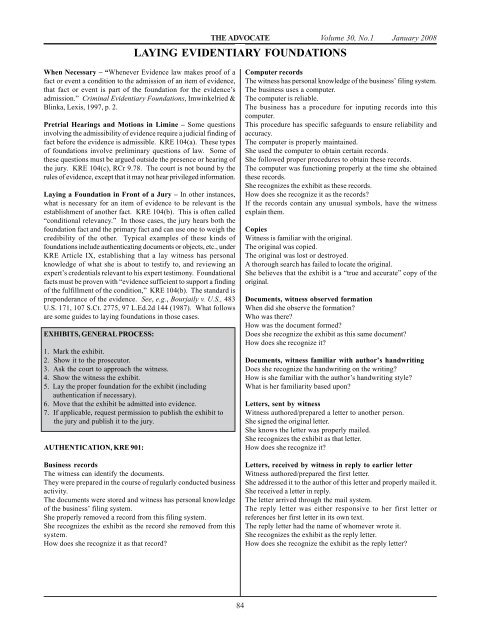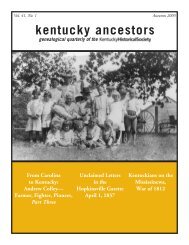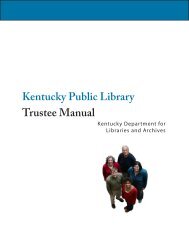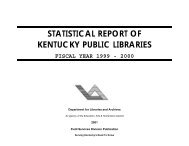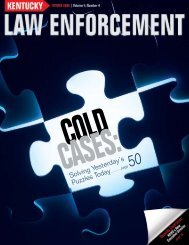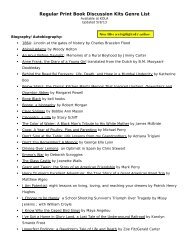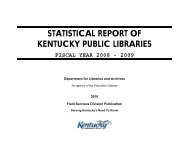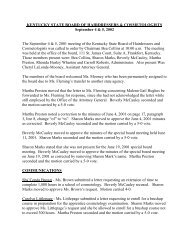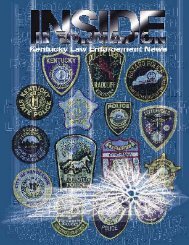Jan08 Advo.pmd - e-archives Home
Jan08 Advo.pmd - e-archives Home
Jan08 Advo.pmd - e-archives Home
You also want an ePaper? Increase the reach of your titles
YUMPU automatically turns print PDFs into web optimized ePapers that Google loves.
THE ADVOCATE<br />
LAYING EVIDENTIARY FOUNDATIONS<br />
When Necessary – “Whenever Evidence law makes proof of a<br />
fact or event a condition to the admission of an item of evidence,<br />
that fact or event is part of the foundation for the evidence’s<br />
admission.” Criminal Evidentiary Foundations, Imwinkelried &<br />
Blinka, Lexis, 1997, p. 2.<br />
Pretrial Hearings and Motions in Limine – Some questions<br />
involving the admissibility of evidence require a judicial finding of<br />
fact before the evidence is admissible. KRE 104(a). These types<br />
of foundations involve preliminary questions of law. Some of<br />
these questions must be argued outside the presence or hearing of<br />
the jury. KRE 104(c), RCr 9.78. The court is not bound by the<br />
rules of evidence, except that it may not hear privileged information.<br />
Laying a Foundation in Front of a Jury – In other instances,<br />
what is necessary for an item of evidence to be relevant is the<br />
establishment of another fact. KRE 104(b). This is often called<br />
“conditional relevancy.” In those cases, the jury hears both the<br />
foundation fact and the primary fact and can use one to weigh the<br />
credibility of the other. Typical examples of these kinds of<br />
foundations include authenticating documents or objects, etc., under<br />
KRE Article IX, establishing that a lay witness has personal<br />
knowledge of what she is about to testify to, and reviewing an<br />
expert’s credentials relevant to his expert testimony. Foundational<br />
facts must be proven with “evidence sufficient to support a finding<br />
of the fulfillment of the condition,” KRE 104(b). The standard is<br />
preponderance of the evidence. See, e.g., Bourjaily v. U.S., 483<br />
U.S. 171, 107 S.Ct. 2775, 97 L.Ed.2d 144 (1987). What follows<br />
are some guides to laying foundations in those cases.<br />
EXHIBITS, GENERAL PROCESS:<br />
1. Mark the exhibit.<br />
2. Show it to the prosecutor.<br />
3. Ask the court to approach the witness.<br />
4. Show the witness the exhibit.<br />
5. Lay the proper foundation for the exhibit (including<br />
authentication if necessary).<br />
6. Move that the exhibit be admitted into evidence.<br />
7. If applicable, request permission to publish the exhibit to<br />
the jury and publish it to the jury.<br />
AUTHENTICATION, KRE 901:<br />
Business records<br />
The witness can identify the documents.<br />
They were prepared in the course of regularly conducted business<br />
activity.<br />
The documents were stored and witness has personal knowledge<br />
of the business’ filing system.<br />
She properly removed a record from this filing system.<br />
She recognizes the exhibit as the record she removed from this<br />
system.<br />
How does she recognize it as that record?<br />
84<br />
Volume 30, No.1 January 2008<br />
Computer records<br />
The witness has personal knowledge of the business’ filing system.<br />
The business uses a computer.<br />
The computer is reliable.<br />
The business has a procedure for inputing records into this<br />
computer.<br />
This procedure has specific safeguards to ensure reliability and<br />
accuracy.<br />
The computer is properly maintained.<br />
She used the computer to obtain certain records.<br />
She followed proper procedures to obtain these records.<br />
The computer was functioning properly at the time she obtained<br />
these records.<br />
She recognizes the exhibit as these records.<br />
How does she recognize it as the records?<br />
If the records contain any unusual symbols, have the witness<br />
explain them.<br />
Copies<br />
Witness is familiar with the original.<br />
The original was copied.<br />
The original was lost or destroyed.<br />
A thorough search has failed to locate the original.<br />
She believes that the exhibit is a “true and accurate” copy of the<br />
original.<br />
Documents, witness observed formation<br />
When did she observe the formation?<br />
Who was there?<br />
How was the document formed?<br />
Does she recognize the exhibit as this same document?<br />
How does she recognize it?<br />
Documents, witness familiar with author’s handwriting<br />
Does she recognize the handwriting on the writing?<br />
How is she familiar with the author’s handwriting style?<br />
What is her familiarity based upon?<br />
Letters, sent by witness<br />
Witness authored/prepared a letter to another person.<br />
She signed the original letter.<br />
She knows the letter was properly mailed.<br />
She recognizes the exhibit as that letter.<br />
How does she recognize it?<br />
Letters, received by witness in reply to earlier letter<br />
Witness authored/prepared the first letter.<br />
She addressed it to the author of this letter and properly mailed it.<br />
She received a letter in reply.<br />
The letter arrived through the mail system.<br />
The reply letter was either responsive to her first letter or<br />
references her first letter in its own text.<br />
The reply letter had the name of whomever wrote it.<br />
She recognizes the exhibit as the reply letter.<br />
How does she recognize the exhibit as the reply letter?


